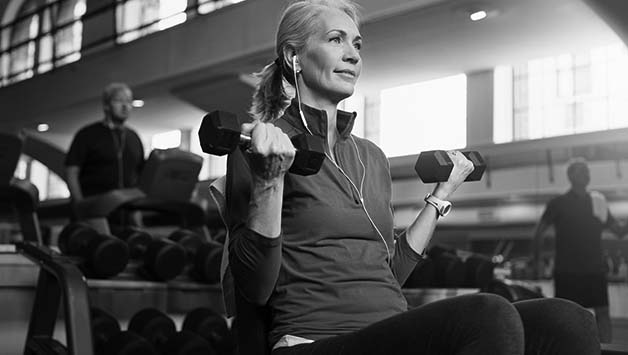
Regular exercise is vital for good health at all stages of life, but it’s especially important if you want to stay active as you age. Strength training is one of the essential exercises for older adults, according to the National Institute on Aging, because it builds muscle that enables you to do other types of exercise. Yet, if you’re over 50, that’s not the only reason to follow a senior strength training program.
The main reason to incorporate strength training into your routine is to counteract sarcopenia, the loss of muscle mass and strength that occurs with age.
After age 30, muscle mass decreases at a rate of 3–8% each decade. Even more challenging, according to health and wellness expert Dr. Wayne Westcott, is that rate nearly doubles after we reach age 50. This makes sarcopenia a top cause of functional decline in seniors. As many as 30% of seniors report trouble with basic tasks, like walking and climbing stairs, showing how sarcopenia can result in loss of independence.
If you have yet to form a senior strength training program, you can easily get started with one that isn’t time-intensive yet produces fast results.
The U.S. Department of Health and Human Services recommends spending 20 to 30 minutes, two to three days per week, on strength training. Dr. Westcott says programs such as these have resulted in three to four pounds of muscle gained in under four months.
A focus on your muscles helps you not only maintain your independence but also live a better quality of life. This is because strength training can:
You’ll also enjoy cardio benefits of strength training. Building muscle can burn calories, improve cholesterol, lower blood pressure, and control blood sugar. Ultimately, you can lose weight, decrease the risks of disease, and even reverse existing problems. This is especially true when eating a balanced diet with exercise.
The best strength training programs for seniors will always prioritize safety. Remember to check with your doctor before you start. Once you have the okay to begin, you can ease into strength training with low-impact exercises. The following arm and leg workouts for seniors let you use your body weight to build a foundation for strength training.
Stand with your feet hip-distance apart, with your toes pointed forward. Your arms should be straight out in front of you. Keep your abdominal muscles tight while you bend your knees and push your hips back, moving to a near-seated position. Then, with your feet planted firmly, push through your heels to return to standing. If you need help staying balanced, you may lower into a chair, just barely touching it before pushing back up with your heels. Repeat 10 times, or as many times you feel is a safe number for you, to work several muscles from your core down.
Overhead press
You may do this arm, back, and shoulder exercise seated or standing. Yet, if you are getting started with strength training, you may opt for the latter. Sit tall in your chair with your knees above your ankles. Bend your elbows and bring your hands in front of your shoulders. Your palms should face out. Then, lift both arms above your head and bring them back down. Make it a habit to time your breathing with each move. Inhale as your arms go up and exhale as they come down. Be sure to keep your shoulders back and relaxed and your stomach muscles engaged. Again, repeat 10 times or more, if able.
For this move that works your legs and glutes, you will need a set of stairs. Bring your left foot to the first step, holding on to the handrail for balance. Push through your left leg to straighten it, while bringing your right leg up to meet it. Then, bend your left leg as you move your right leg back to its original position. Do this 10 times, or fewer if necessary, and then switch the position of your legs to exercise the other side of your body.
As you grow confident with strength training, an internet search for other workouts and health tips can help you expand your senior strength training program.
One way to further develop your strength training is to add free weights to your workouts. This allows you to increase resistance and further strengthen your muscles. If you don’t have weights, such as dumbbells or a kettlebell, you can use items you have at home, like water bottles or canned foods.
You can integrate weights into each exercise above. When doing squats, for example, you may choose to hold one weight in both hands close to your chest. You may instead use two dumbbells, holding one in each hand at shoulder height. Please note, when using weights for any exercise, it’s important you’re able to maintain appropriate form to avoid injury.
Photo credit: iStock
Wellabe offers life and supplemental health insurance plans to help you prepare for good days and bad. We’ll always be here to empower you to be well — well prepared, well protected, and well loved.